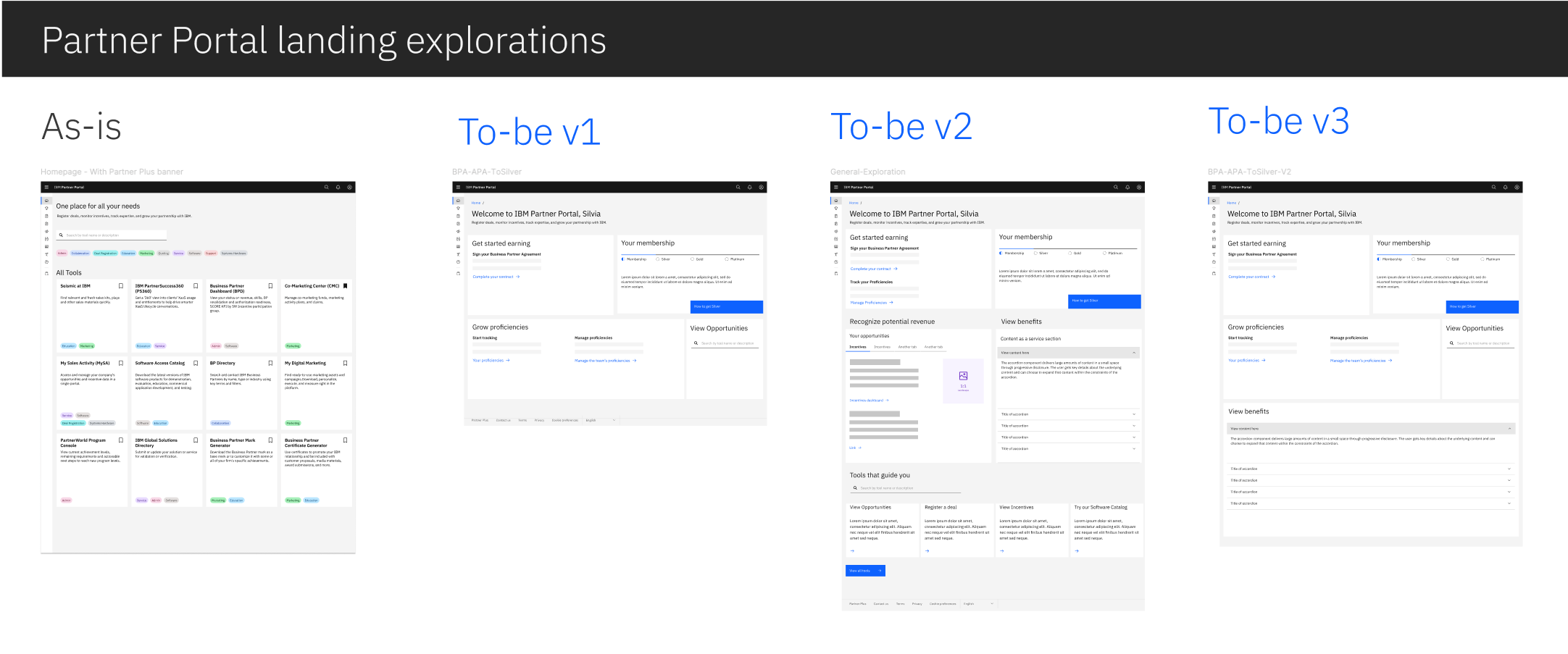IBM Partner Personalization
Personalizing an IBM Partner experience
Intro
IBM’s Partner Program comprises a variety of complex contracts tailored to different business needs, with some companies utilizing multiple contracts. To simplify the process and encourage contract adoption within IBM’s Partner Portal, the initiative focused on streamlining the Partner experience through personalization.
Objectives
Support partners in signing contracts and understanding their program status, enabling them to leverage benefits and incentives.
Increase contracting rates while reducing the time Partners spend on signing contracts.
An existing research insight
Partners expressed a strong need for personalized experiences to simplify tasks and reduce the time spent on administrative processes.
Representation of the As-Is Landing experience in the IBM Partner Portal and potential To-Be explorations.
Discovery & research
Pain points identified
Complexity in progressing tier levels due to diverse variables.
Lack of visibility into employee progress within the program.
No integration of an external training platform for real-time competency progress tracking.
Focus areas
Encourage new Partners to sign contracts to surface Partner benefits and incentives in IBM's Partner Plus program.
Show the Partner where they are currently in the program and what they need to move to the next tier.
Methods
User interviews: Interviewed Partners to understand what the user wanted.
Competitive analysis: Analyzed and compared other Partner programs.
User testing: We utilized UserTesting.com with a Figma prototype for testing the intuitiveness of the proposed designs.
Key approaches
Content as a Service (CaaS) emerged as a vital approach to deliver contextual content and guide Partners through relevant tasks.
Leveraged Salesforce’s eligibility codes to determine what type of contract an existing Partner had.
Representation of the MVP's personas, including downstream touch points and the areas affected by the personalized experience.
My Role as Lead Product Designer
As a Lead Product Designer, I:
Mapped the end to end journey and touch points: Created end-to-end user flows and journey maps, from registration to landing to understand gaps in the program and experience.
Detailed journeys: Created detailed user flows and journey maps, such as guiding new Partners from registration to contract signing. For example, mapping this process uncovered confusion around contract selection and lack of real-time status updates.
Design system consistency: Strategically selected Carbon components (IBM’s design system) to accelerate development and ensure consistency. Delivered visual UI designs and collaborated with engineers to address layout, data, and component gaps.
Design sessions: Conducted tri-weekly design sessions with a content strategist and another UX designer.
Design and Engineering show and tells: Embedded with an engineering squad to attend and run daily show and tells to present explorational designs and to understand technical limitations.
Collaboration check-ins: Acted as the main liaison between engineers, design, content, key stakeholders, and product owner. Scheduled consistent design check-ins to assess hurdles, and to inform the product owner and other stakeholders.
Executed designs for an MVP and a future state approach: Leveraged existing quantitative and qualitative data to inform various states for an MVP product and potential future states.
Solutions
Personalized landing experience: Tailored experiences for new IBM reseller Partners with an option for a refreshed, broader audience landing page.
Training platform integration: Connected Partner experiences to external platforms to monitor employee progress in the program.
Content as a Service (CaaS) Implementation: Presented contextual content within the experience to guide IBM Partners to complete tasks.
Roadblocks & resolutions
Stakeholder alignment: Reached consensus on content structure and branding through iterative discussions.
Technical constraints: Worked closely with engineers to navigate Salesforce capabilities and external platform data integrations.
Time Zone challenges: Initially, it was a challenge to coordinate in-person design sessions through Microsoft Teams with a London-based team and a six-hour time difference. However, I began to leverage the time differences for a continuous and productive workflow. I could initiate a design, challenge, or concept, and then have the London team take it over and converge in the morning. It was a rinse and repeat cycle.
Delivered & shipped
Successfully launched a personalized partner landing experience with an affordance back to the classic experience. This enabled the partner/user to have a choice between experiences. The team agreed to a research and stakeholder compromise.
Delivered over 10 personalized journey states for contract signing and program progression in a three-month time frame.
Achieved a significant reduction in partner time-to-contract. Quantitative metrics validated the time reduction.
IBM Partner Portal Personalization MVP Landing experience
Post launch
Evolution and proposed future states
Iterated from a reseller-specific persona journey to an agnostic persona landing journey. This enabled a broader persona audience to achieve similar results while maintaining the cohesiveness of the experience. e.g., a Partner with a different type of contract could make their selection in a broader experience.
Personalize IBM Partner Benefits and tailor benefits to a specific contract type. This would be an extension of the landing experience.
Leverage existing content for an AI conversational experience; form and function were to be researched or determined. I conducted early explorations or visionary work, but they were interrupted and not approved. Organizational conflicts and prioritizations hindered the implementation of this recommendation.




